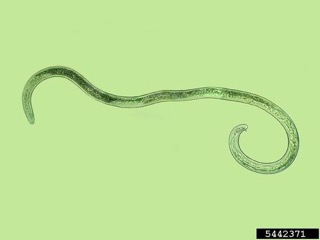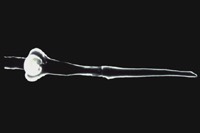Meloidogyne Incognita: Difference between revisions
No edit summary |
|||
| Line 38: | Line 38: | ||
[[File: Stylet.jpeg |500px|thumb|left| Image showing a Root-Knot Nematode's Stylet [5]]] | [[File: Stylet.jpeg |500px|thumb|left| Image showing a Root-Knot Nematode's Stylet [5]]] | ||
== Impacts of Root-Knot Nematodes == | |||
Revision as of 08:26, 18 April 2025
Taxonomy
| Domain | Kingdom | Phylum | Class | Order | Family | Genus | |
|---|---|---|---|---|---|---|---|
| Classification | Eukaryota | Animalia | Nematoda | Chromadorea | Tylenchida | Heteroderidae | Meloidogyne |
The Taxonomy of the Meloidogyne Incognita, also commonly called Root-Knot Nematodes [1]

Appearance & Life Cycle
Root-Knot Nematodes have multiple juvenile stages in their lifetime. In their earliest juvenile forms, male and female nematodes are vermiform, meaning they appear like skinny worms. These nematodes grow through molting and shedding their outer layer to allow them to increase in size. Adult males keep the worm shape, whereas females grow into a more spherical shape as they grow. These nematodes grow to be 1/10 the size of a pinhead and are too small to be seen by the human eye, they're also transparent. Females plant their eggs at the root surface in the soil.[2]
Habitat
Root-Knot Nematodes can be found in the soil worldwide, thriving especially in areas where the climate is hot with winters that are short and not severe drops in temperature. Greenhouses make for the perfect area for these Nematodes to reproduce.[4] Male nematodes move throughout the soil and leave the roots of a plant to go and obtain nutrients. Female's however, stay in a certain area of the root and feed there their whole life until it is time to reproduce. Once they are big enough to reach the top of the root surface, they lay their eggs in the soil. These nematodes are endogeic, meaning they spend their whole lives in the soil.[2]
The Stylet & How it Works
Root-Knot Nematodes possess a stylet that all plant-parasites have that aids in their getting nutrients from the plant roots. This stylet sticks out and is used to inject secretions and ingest nutrients from the roots and soil. When the Nematode first penetrates a root cell, it secretes secretory proteins into the cell. These parasitized cells are great "giant cells", meaning that the nucleus of the cell continues to grow and create multiple nuclei, but the cell will never divide. This benefits the nematode because they know they will stay at this point and continue to feed on the now more abundant and easily accessible proteins from the large nucleus. A feeding tube is secreted from the stylet that goes into the plant cytoplasm to filter and obtain cytosol, which is what they feed on. This allows the nematodes not to have to move, but still have the necessary nutrients to survive.[5]
